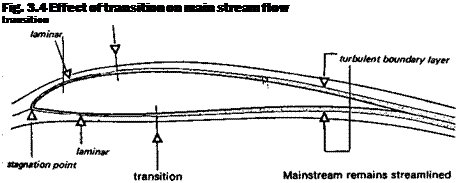TURBULENT BOUNDARY LAYERS
[t^n a turbulent boundary layer there is no tidy system of sliding layers. Instead air particles move with a good deal of freedom, up and down as well as in the general direction of the main flow. Although any one particle moves along at unsteady speed, the average rate of flow near the wing skin in the lowest parts of the turbulent boundary layer is considerably faster than it was before transition. This increases the skin friction, but because the particles are moving faster, they have greater momentum and are less easily halted. A typical velocity diagram for such a boundary layer after transition is considerably thicker as a whole than before, and as the Re rises further (i. e., as the flow moves further towards the trailing edge), the turbulent boundary layer continues to
 |
‘ thicken. The main airstream above the boundary layer has to accommodate to this sharp thickening of the b. l. in the transition zone, and to the further thickening thereafter. In
addition to the increased skin friction, the turbulent boundary layer, by compelling the main flow to accommodate in this way, increases the form drag of the wing profile (Fig. 3.4). It is as if the profile were thicker, causing a larger disturbance to the mainstream.
A very smooth surface, free from dirt, waves and other flaws, may delay transition. Transition on such surfaces moves aft, the critical Re in the boundary layer is high. A rough surface, or one with relatively large waves or bumps, brings transition forward, reducing the critical Re. For each type of surface there is a critical boundary layer Reynolds Number which for a given speed of mainstream flow is reached at some particular point. If the mainstream flow speeds up, the critical Re remains the same but it is reached earlier; i. e. the transition point or zone moves forward as speed rises, and back as speed is reduced. With full-sized aircraft transition usually takes place quite near the leading edge of wings, unless special aerofoils and very smooth surfaces, or other devices such as boundary layer suction, to remove the turbulent layers as it forms, are used. With models laminar flow tends to persist, which at first seems to give such small wings an advantage in terms of drag. Unfortunately other factors arise because of changes of pressure associated with the generation of lift by the wing.













